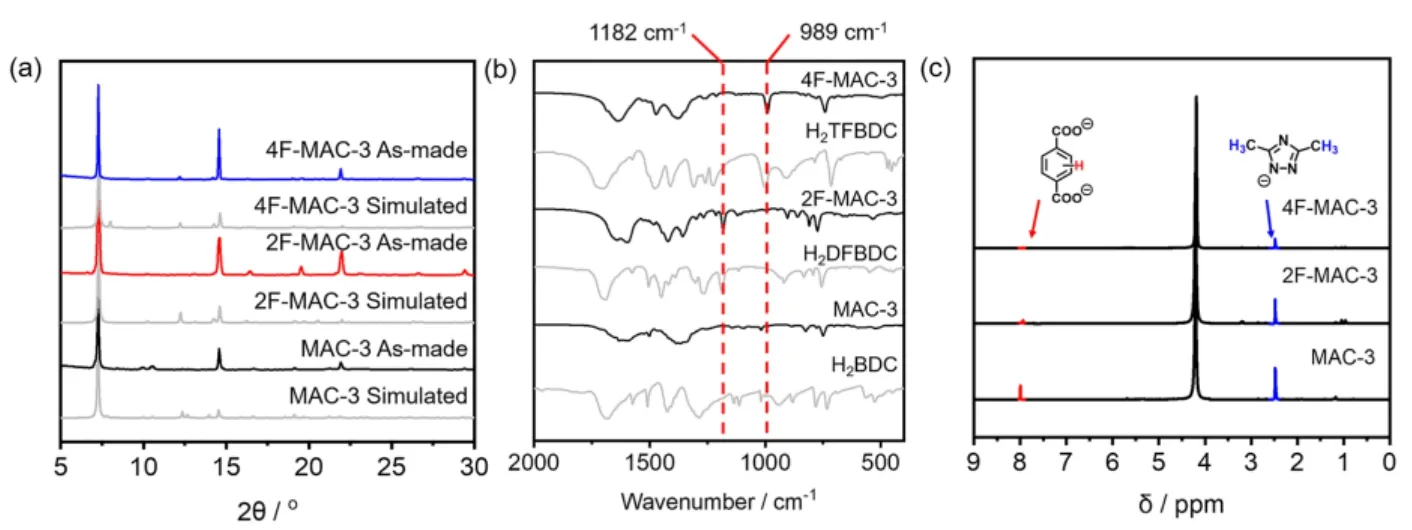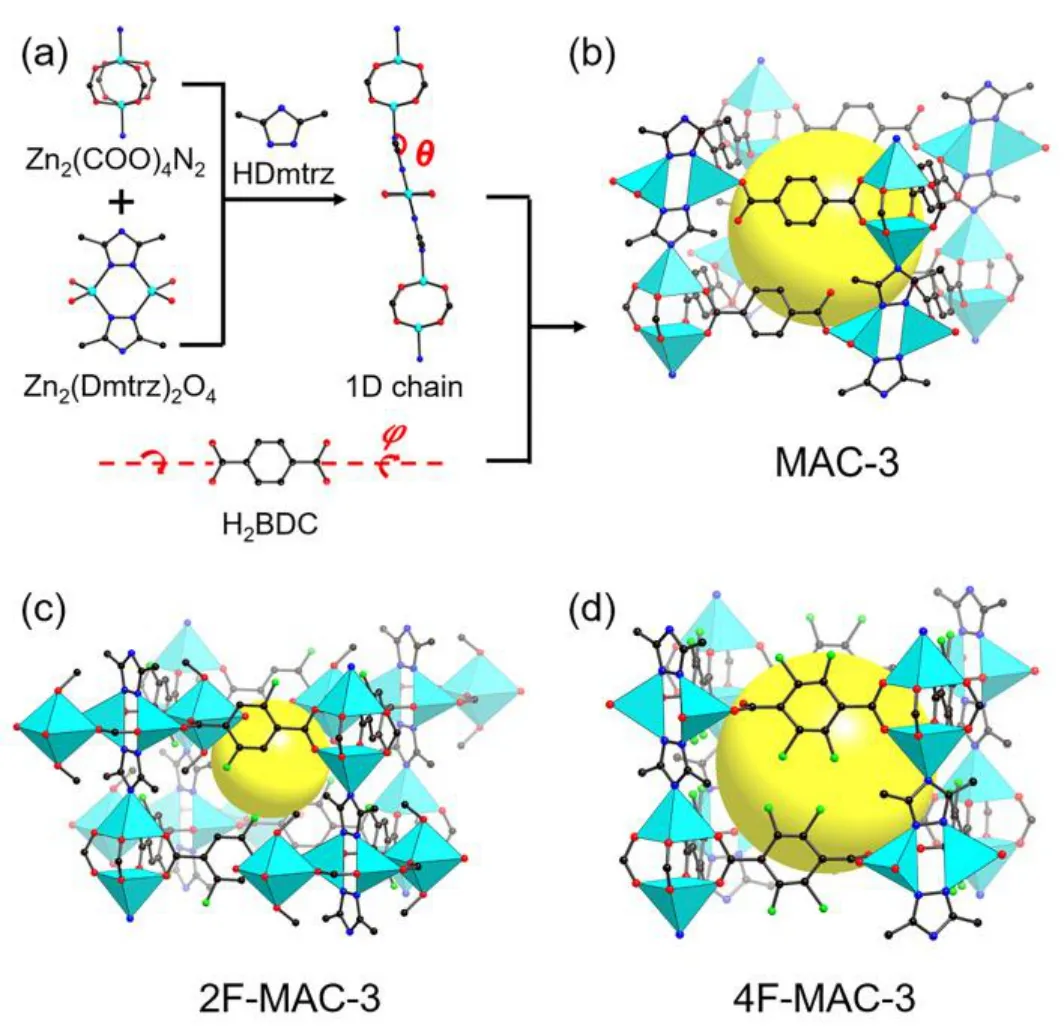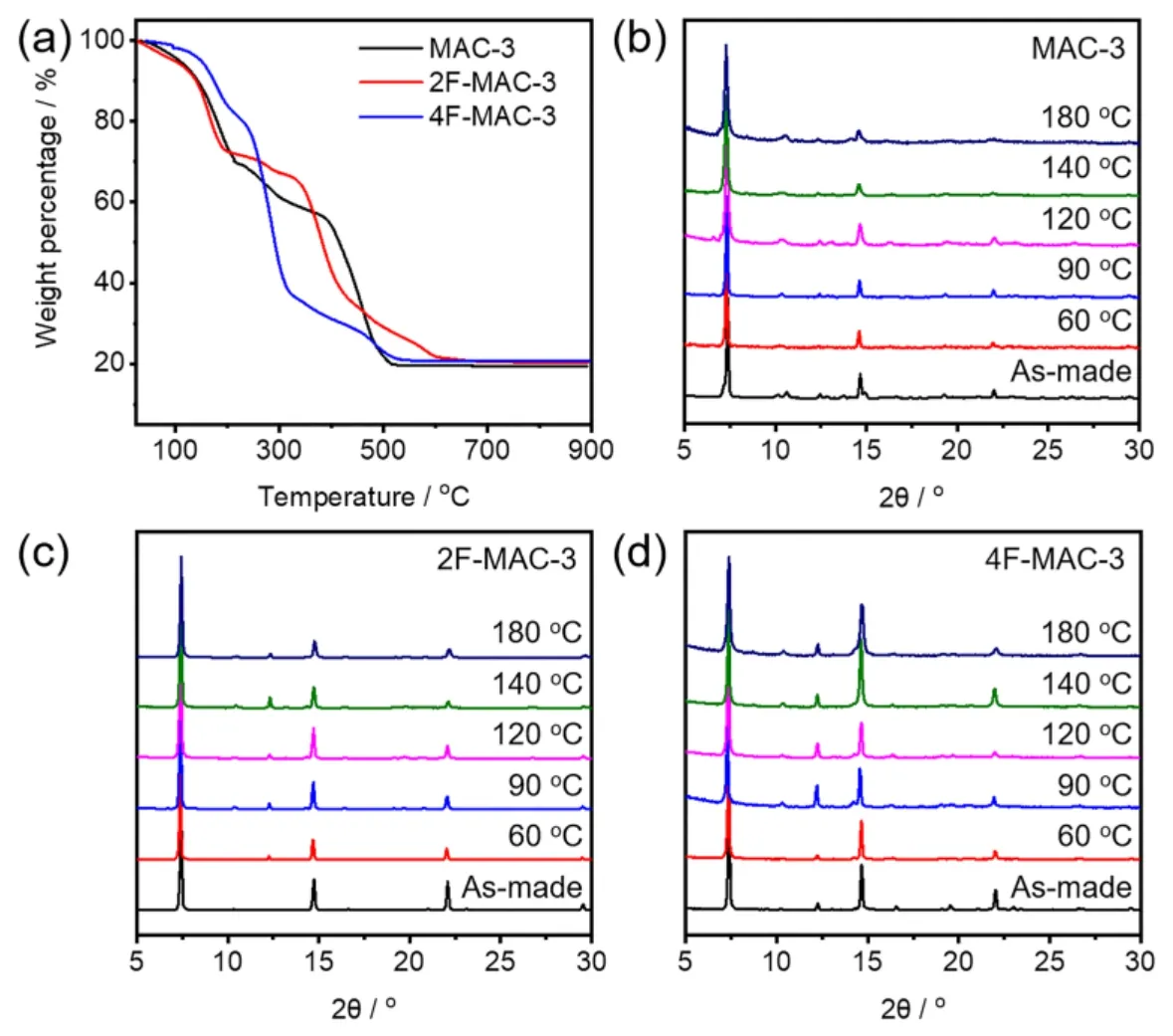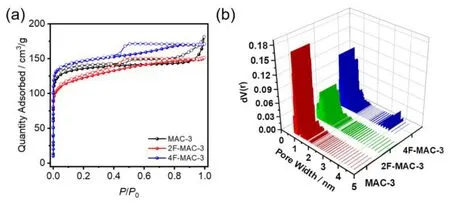Effect of Fluorination on the Crystal Structure, Stability and Gas Adsorption Property in Zinc(II)Metal-organic Frameworks①
2022-03-08ZHANGXinCHENZhenXiaYANGYongTaiDENGMingLiWENGLinHong
ZHANG Xin CHEN Zhen-Xia YANG Yong-Tai DENG Ming-Li WENG Lin-Hong
(Shanghai Key Laboratory of Molecular Catalysis and Innovative Materials,Department of Chemistry, Fudan University, Shanghai 200433, China)
ABSTRACT Three zinc(II) metal-organic frameworks (xF-MAC-3) have been synthesized by using Zn(II) salts,3,5-dimethyl-1H-1,2,4-triazole (Hdmtrz) and different fluorination degree carboxylate ligands, which are analogic structures and can be described as (6,6)-connected pcu-b net. We find that the fluorine atoms have structural regulation effect on xF-MAC-3, which can not only enlarge the torsion angle of carboxylate ligands but also elevate the space group of structures. Besides, the CO2-273 K uptake increased from 23.21 cm3·g-1 (MAC-3) to 36.13 cm3·g-1 (4F-MAC-3) and H2-77 K uptake increased from 24.33 cm3·g-1 (MAC-3) to 59.79 cm3·g-1(4F-MAC-3), which means fluorination can enhance the gas adsorption uptake of xF-MAC-3 analogues.Furthermore, the results of fluorination in xF-MAC-3 analogues offer a potential way to study the ligand pre-functionalization effect on the structures and properties of MOFs analogues.
Keywords: metal-organic frameworks, fluorine functionalization, X-ray crystallography, gas adsorption;
1 INTRODUCTION
Metal-organic frameworks (MOFs) are porous crystalline materials which are constructed by secondary building units(SBUs) and organic ligands[1-3]. In the last two decades, due to their permanent porosity, structural stability and easily functionalization, MOFs have been widely studied in the fields of applications such as gas adsorption and purification[4-6], catalysis[7-9], molecule sensing and recognition[10-12].
Since fluorine atoms have the strongest electronegativity and small electron polarization, introducing fluorine-containing functional groups into MOFs can change the pore channel properties and lead to various applications[13-15], such as hydrocarbon separation[16-19], ionic conductivity[20]and,mostly important, H2and CO2adsorption[21-23]. Nevertheless,fluorination will largely change the acidity and coordination ability of the carboxylate ligand, so that fluorinated analogues of MOFs constructed by carboxylate ligands can hardly be synthesized[24-26]. In recent years, some fluorinated analogues of MOFs have been synthesized and the effects of fluorination on MOFs have been studied[27-29]. However, there are still some challenges to figure out the effect of fluorination in MOFs for crystal structures, stabilities, H2and CO2adsorption properties, which arouses our interests.
Cheetham and co-workers investigated that a series of 3D fluorinated-MOFs can be synthesized by using perfluorinated carboxylates in combination with nonfluorinated nitrogen heterocyclic ligands such as imidazole[30], triazole[31], and both bipyridine[32]. Inspired by this, we synthesized three analogic structures (xF-MAC-3) based on our previous work[33]by using Zn(II) salts, 3,5-dimethyl-1H-1,2,4-triazole(Hdmtrz) and different fluorination degree carboxylate ligands.We also discuss the effects of fluorination on MOFs structure,thermal and chemical stability, H2and CO2adsorption properties in detail.
2 EXPERIMENTAL
2. 1 General materials and methods
All reagents were purchased from commercial sources and used without further purification, except for 3,5-dimethyl-1H-1,2,4-triazole (HDmtrz) and 2,5-difluoroterephthalic acid(H2DFBDC), which were synthesized according to the references[34,35]. Fourier Transform Infrared Spectra (FT-IR)were performed on a ThermoFisher Nicolet iS10 FT-IR spectrometer in the range of 4000~400 cm-1with KBr pellets.Elemental analyses of C, N and H were tested on the Elementar Vario EL III. Powder X-ray diffraction (PXRD)was measured by using a Bruker D8 Advance diffractometer with Cu-Kαradiation (λ= 1.5406 Å). Thermogravimetric analyses (TGA) were carried out on SDT Q600 with the temperature range of 30~900 °C under N2flow at a heating rate 10 °C·min-1. Gas adsorption analyses were tested on the Micromeritics ASAP 2020 surface area analyzer. Before gas sorption, the as-made MOF samples (about 100 mg) were exchanged with dichloromethane (10 mL for three times) and then degassed at 140 °C for 10 hours.
2. 2 X-ray crystallographic study
Single-crystal X-ray diffraction (SC-XRD) of all compounds was performed on a Bruker D8 Venture MetalJet with Ga-Kαradiation (λ= 1.3414 Å) at 173 K. Data collection and reduction were performed with APEX III, and empirical absorption corrections were applied by the SADABS program.Structures were solved by direct methods using the SHELXS program and refined with the SHELXL program[36].Non-hydrogen atoms and N-bondedHatoms were directly obtained from a difference Fourier map.C-bonded H atoms were placed geometrically and refined as riding modes. Final refinements were carried out by full-matrix least-squares methods with anisotropic thermal parameters for all non-hydrogen atoms onF2. SQUEEZE method was used to consider the disorder in the channel of the structures[37].
2. 3 Syntheses
2. 3. 1 3,5-Dimethyl-1H-1,2,4-triazole (HDmtrz)
Acetamide (60 g, 1 mol) and 80 wt% hydrazine hydrate (30 g, 0.5 mol) were added into a 250 mL flask and heated at 120 °C for 3 h, when the reaction solution first turned pink and then became colorless. After that, the reaction temperature was increased to 180 °C for 3 h and about 30 mL of liquid was distilled. Finally, the temperature was further increased to 240 °C and colorless liquid was distilled, which was condensed on the tube as white solid product (8.98 g, 0.09 mol). Yield: 9%.1H NMR (DMSO-d6) showedδ= 13.13 (s,1H), 2.20 (s, 6H).
2. 3. 2 2,5-Difluoroterephthalic acid (H2DFBDC)
2,5-Difluoro-4-methylbenzoic acid (5.6 g, 33.5 mmol),N-bromosuccinimide (NBS, 29.5 g, 165 mmol) and benzoyl peroxide (BPO, 0.4 g) were added into 100 mL CCl4and refluxed at 120 °C for 48 h and the reaction system changed into orange color. The hot mixture was filtered and washed successively with hot CCl4, and the organic solution was extracted with 1 M HCl by three times, dried over anhydrous MgSO4, filtered and evaporated. The remaining orange solid was the intermediate product with the mess of 9.14 g.1H NMR (DMSO-d6):δ= 7.71 (q, 1H), 7.61 (q, 1H), 7.41 (s, 1H).
The intermediate product (9.14 g) and sodium periodate(7.17 g, 33.5 mmol) were added into 50 mL 2% H2SO4and refluxed at 90 °C for 24 h. The product was subsequently cooled to room temperature and the cold mixture was filtered,then the precipitate was washed with water. The solids were recrystallized from acetic acid to gain white powder 3.47 g(17.5 mmol). Yield: 52.2%.1H NMR (DMSO-d6):δ= 7.68 (t, 2H).
2. 3. 3 Zn2(BDC)2(Dmtrz)]·(CH3NH3)·2H2O (MAC-3)
Zn(OAc)2·2H2O (75 mg, 0.2 mmol), terephthalic acid(H2BDC, 33 mg, 0.2 mmol) and HDmtrz (10 mg, 0.1 mmol)were added to 10 mLN,N-dimethylformamide (DMF) and stirred for 10 min. Then the solution was sealed in a Teflon-lined stainless-steel autoclave (15 mL) and heated at 140 °C for 3 days, followed by cooling down to room temperature. Colorless block crystals were collected by filtration. Yield: 75% based on the Zn(OAc)2·2H2O. Elemental analysis calculated for MAC-3 (Zn2C21H24N4O10, 623.19):C, 40.41; N, 8.98; H, 3.85%. Found: C, 40.50; N, 9.41; H,3.78%. FT-IR (cm-1): 3426m, 3059m, 2963m, 2794m, 2484w,1952w, 1632vs, 1599vs, 1492s, 1393vs, 1253w, 1136w,1099m, 10118m, 875w, 816m, 753s, 694w, 592w, 514m (Fig. 1b).
2. 3. 4 Zn3(H2O)2(MeO)2(DFBDC)2(Dmtrz)]·(CH3)2NH2(2F-MAC-3)
[Zn(NO3)2·6H2O (87 mg, 0.3 mmol), H2DFBDC (40 mg,0.2 mmol) and HDmtrz (10 mg, 0.1 mmol) were added to the mixture solution of DMF (2 mL) and methanol (MeOH, 8 mL), and the mixture was stirred for 10 min. Subsequently,the mixture was sealed in a Teflon-lined stainless-steel autoclave (15 mL) and heated at 90 °C for 12 h, followed by cooling down to room temperature. Colorless block crystals were collected by filtration. Yield: 60% based on the Zn(NO3)2·6H2O. Elemental analysis calculated for 2F-MAC-3 (Zn3C24H28N4O12F4, 836.61): C, 34.42; N, 6.69; H,3.35%. Found: C, 34.45; N, 6.65; H, 3.30%. FT-IR (cm-1):3411m, 3073w, 2978m, 2927w, 2878w, 2448w, 2033w,1646vs, 1588vs, 1486m, 1419vs, 1356s, 1264m, 1213m,1183s, 1121m, 1026w, 988w, 945w, 900m, 853m, 808s, 774s,706w, 657w, 529m (Fig. 1b).
2. 3. 5 [Zn2(TFBDC)2(Dmtrz)]·H2O (4F-MAC-3)
Zn(NO3)2·6H2O (87 mg, 0.3 mmol), 2,3,5,6-tetrafluoroterephthalic acid (H2TFBDC, 48 mg, 0.2 mmol) and HDmtrz (10 mg, 0.1 mmol) were added to the mixture solution ofN,N-diethylformamide (DEF, 2 mL) and MeOH (8 mL), and the mixture was stirred for 10 min. Then the mixture was sealed in a Teflon-lined stainless-steel autoclave (15 mL) and heated at 90 °C for 12 h, followed by cooling down to room temperature. Light purple block crystals were collected by filtration. Yield: 65% based on Zn(NO3)2·6H2O. Elemental analysis calculated for 4F-MAC-3 (Zn2C20H9N3O9F8, 718.04):C, 33.42; N, 5.84; H, 1.24%. Found: C, 33.50; N, 5.94; H,1.20%. FT-IR (cm-1): 3422m, 2921w, 2941w, 2874w, 2361w,1639vs, 1474m, 1419vs, 1356s, 1264m, 1213m, 1183s,1121m, 1026w, 988w, 945w, 900m, 853m, 808s, 774s, 706w,657w, 529m (Fig. 1b).
3 RESULTS AND DISCUSSION
3. 1 Synthesis and general characterization
Zn2(BDC)2(Dmtrz)]·(CH3NH3)·2H2O (MAC-3) was synthesized by solvothermal method in DMF with the raw material ratio of Zn(OAc)2·2H2O:H2BDC:HDmtrz as 3:2:2 after referring to the previously reported method[33]. However,we failed to acquirexF-MAC-3 (x= 2 or 4) under the same synthesis conditions, which we believed that was mainly due to the introduction of fluorine atoms[38]. Due to the strongest electronegativity and electron polarization of the fluorine atom, the electronic density on the benzene ring and the ligand acidity would change after the introduction of the fluorine atom into the carboxylate ligand. As the number of fluorine atoms increases, the electronic density of the benzene ring would decrease while the ligand acidity would increase,which changed the coordination ability of the carboxylate ligand and affected the synthesis of MOF materials. Therefore,we used zinc nitrate with stronger coordination ability as the metal salt during the synthesis of 2F-MAC-3. We also introduced methanol with low boiling point and strong polarity into the solvent system and used milder reaction conditions to gain high quality 2F-MAC-3 single crystal.During the synthesis of 4F-MAC-3, we replaced DMF with DEF, which had better ligand solubility and helped to obtain the single-crystal test-qualified 4F-MAC-3 sample.
The PXRD pattern ofxF-MAC-3 samples fitted well with the simulated data, confirming the pure phase of all samples(Fig. 1a). The existence of fluorine atoms in the structures was checked by using1H NMR and FT-IR spectroscopy. The FT-IR spectra of 2F-MAC-3 and 4F-MAC-3 had absorption peaks at 1182 and 989 cm-1, respectively, which could be ascribed as the stretching vibration peaks of C–F bonds,showing the presence of fluorine functionalized ligands(Fig. 1b)[39]. Furthermore, the disappearance of C–H non-planar deviational vibration peaks in the range of 950~780 cm-1in 4F-MAC-3 FT-IR spectrum also implied the absence of C–H bonds in 4F-MAC-3, certifying that the carboxylate ligand in 4F-MAC-3 is TFBDC[40]. The1H NMR spectroscopy showed the ligand composition ofxF-MAC-3 structures. The1H NMR spectra of MAC-3 and 2F-MAC-3 had two NMR peaks with different chemical shifts, where the peak atδ7.99 could be ascribed as the benzene ring hydrogen of carboxylate ligand (-PhH) and that atδ2.48 was the methyl hydrogen of the Dmtrz ligand (-CH3), respectively (Fig. 1c).The ratio of the two ligands closed to 1:1 calculated by the peak integrating area, which was consistent with the structural molecular formula results. There was only one peak in the1H NMR spectrum of 4F-MAC-3 atδ2.44, which was the methyl hydrogen (-CH3) of the Dmtrz ligand. The absence of other chemical shift peaks also proved that the carboxylate ligand in 4F-MAC-3 is TFBDC.

Fig. 1. (a) PXRD pattern; (b) FT-IR spectra; (c) 1H NMR spectra of xF-MAC-3 (x = 0, 2, 4)
3. 2 X-ray crystal structure
As a prototype structure, single-crystal X-ray diffraction study revealed that MAC-3 crystallized in monoclinic system,C2/mspace group (Table S1). The asymmetric unit of MAC-3 contained two crystallographically independent Zn(II). Four carboxylate groups in BDC ligands andNatoms in Dmtrz ligands coordinated to Zn(1) and Zn(1)A(A: 1–x,y, 2–z),forming zinc paddle-wheel SBU [Zn2(COO)4N2]. Two Dmtrz ligands coordinated to Zn(2) and Zn(2)B(B: 1–x, 1–y, 1–z)viaaμ1,2-bridging mode to construct triazolate-dinuclear SBUs[Zn2(Dmtrz)2O4] (Fig. 2a). Two SBUs connected with each other to generate a 1D chain structure with a folding angleθof 168.78°, and such chains are linked by BDC ligands along thexandyaxes to form a 3D structure with a 7.0Å × 7.0Å channel along thecaxis (considering van der Waals radius,Fig. 2b). Considering paddle-wheel and triazolate-dinuclear as 6-connected SBUs, MAC-3 could be defined as a (6,6)-connectedpcu-b topology net (Fig. S1)[41].

Fig. 2. (a) Secondary building units and organic ligands of xF-MAC-3; (b)~(d) Single-crystal structures of xF-MAC-3
Based on the MAC-3 prototype structure, we replaced BDC ligand by fluorine-functionalized ligands to synthesize iso-structures and 2F-MAC-3 & 4F-MAC-3 were subsequently isolated (Fig. 2c, d, Fig. S2, 3 and Table S1). Distinct structural changes concerning the carboxylate ligands, 1D chain and SBUs are summarized in Table 1 and Fig. 1b, which mainly included (i) space group elevated fromC2/m(MAC-3)toImmm(2F-MAC-3 & 4F-MAC-3); (ii) the folding angleθof 1D chain changed from obtuse angle (168.78°) into straight angle (180°); (iii) the torsion angle in BDC ligands turned into right angle; (iv) trianzolate-dinuclear SBU changed into a novel zinc tetranuclear SBU when the BDC ligand was replaced by fluorine-functionalized DFBDC ligands. The 1D channel size of 2F-MAC-3 is 4.0Å × 6.8Å (considering van der Waals radius) which is smaller than MAC-3. The channel of 2F-MAC-3 is smaller than MAC-3 mainly caused by the larger zinc tetranuclear SBU in 2F-MAC-3, which reduced the size of 1D channel in MOFs. Furthermore, the 1D channel size of 4F-MAC-3 is 6.8Å × 6.8Å (considering van der Waals radius) which is slightly smaller than MAC-3. Considering the SBUs in 4F-MAC-3 are the same with MAC-3, the smaller 1D channel in 4F-MAC-3 is due to the relatively larger size of fluorine atoms.
There are two important differences in the chemistry of fluorine-functionalized BDC ligands compared to their nonfluorinated analogues, which caused the structural changes inxF-MAC-3 mentioned above. The first difference among three carboxylate ligands is the pKavalue. As discussed, the pKavalue of BDC-derived ligands decreases with the increasing number of fluorine atoms on the ligand, which means the acidities of 2F-MAC-3 & 4F-MAC-3 are stronger than MAC-3. So the fluorinated ligands can be deprotonated more easily and coordinated with zinc ions in a multidentate mode. This explains SBUs in MAC-3 are paddle-wheel and triazolate-dinuclear when SBUs in 2F-MAC-3 & 4F-MAC-3 are paddle-wheel and zinc tetranuclear. Secondly, in 2F-MAC-3 & 4F-MAC-3, the fluorine atoms of BDC ligands enlarge the torsion angle to a right angle, by which the carboxylate groups are twisted out of the benzene ring. This can be attributed to (i) an electrostatic repulsion effect between the fluorine atoms on the benzene ring and the lone-pair oxygen atoms on the carboxylate groups; (ii) the decrease in aromatic character of BDC ligands due to the electron-withdrawing nature of the fluorine atoms[42]. The two differences mentioned above cause the folding angleθof 1D chain inxF-MAC-3 (x= 2, 4) become a straight angle, thus inducing structures to crystallize in a higher symmetry space group (Fig. S4). This suggests that the introduction of fluorine atoms into ligand has a structure directing effect on the synthesizedxF-MAC-3.
3. 3 Structural stability
To study the porosity ofxF-MAC-3, we first investigated the thermal and solvent stability ofxF-MAC-3 to determine the activation conditions for gas adsorption test. The TGA analysis reveals that allxF-MAC-3 samples contain two weight loss peaks. The first one from room temperature to 200 °C shows about 25% weight loss, which can be attributed to the departure of guest molecules. The second weight loss peak from 250 to 600 °C results from the decomposition of the framework. For the increasing fluorination degree will weaken the C(-Phenyl)–C(Carboxylate)bond, the decarboxylation reaction will be easy to occur as the degree of fluorination increases, which makes the decomposition temperature significantly shift to lower temperature (420 °C for MAC-3 and 250 °C for 4F-MAC-3, Fig. 3a)[43]. From the variable temperature PXRD patterns ofxF-MAC-3, we can find that the structures will keep the crystallinity until 180 °C, which is consistent with the TGA data (Fig. 3b~d). ImmersingxF-MAC-3 into different solvents (e.g. dichloromethane,methanol, acetone, ethyl acetate) for 2 h, PXRD patterns show no significant changes, indicating thatxF-MAC-3 has good solvent stability and the fluorine-functionalized of the ligands doesn’t affect the solvent stability of the MAC-3 structure(Fig. S5).
3. 4 Gas adsorption properties
The N2-77 K adsorption isotherms ofxF-MAC-3 reveal the presence of microporous structures in the structures. The BET surfaces are 532 m2g-1(MAC-3), 459 m2g-1(2F-MAC-3) and 579 m2g-1(4F-MAC-3, Fig. 3a), respectively. For the channel ofxF-MAC-3 is occupied by cationic CH3NH3+molecules,the experimental BET surfaces are remarkably lower than the theoretical accessible surfaces calculated by Material Studio(van der Waals radius of the probe molecule: 1.84 Å;calculated supercell: 2 × 2 × 2 supercell)[44]. The void space ofxF-MAC-3 is calculated by PLATON software and the data are listed in Table S2[45]. The pore size distribution ofxF-MAC-3 is calculated by DFT model and the maximum pore sizes ofxF-MAC-3 are 5.52 Å (MAC-3), 5.88 Å(2F-MAC-3) and 5.73 Å (4F-MAC-3, Fig. 4b), respectively.

Fig. 3. (a) TGA curves; (b) Variable temperature PXRD patterns of xF-MAC-3

Fig. 4. (a) N2-77K adsorption isotherms; (b) Pore size distribution of xF-MAC-3
H2and CO2adsorption experiments have been used to understand the relationship between gas adsorption capacity and fluorination degree ofxF-MAC-3. CO2-273 K adsorption experiments ofxF-MAC-3 are carried out under 800 mmHg and the uptake ofxF-MAC-3 amount is 23.21 cm3·g-1(1.04 mmol·g-1, MAC-3), 27.50 cm3·g-1(1.23 mmol·g-1,2F-MAC-3) and 36.13 cm3·g-1(1.61 mmol·g-1, 4F-MAC-3)respectively, which show that CO2uptake amount increases when fluorination degree increases on the carboxylate ligands(Fig. 5a~c).

Fig. 5. (a) Low-pressure CO2 adsorption isotherm at 258 and 273 K (solid line: adsorption isotherm;hollow line: desorption isotherm); (b) Adsorption heat (Qst) for xF-MAC-3
To further investigate the effect of fluorination degree on CO2adsorption enthalpy (Qst), we preform 258 K CO2adsorption experiments and the isosteric heat of CO2adsorption is calculated from the Virial method (Fig. S6, Fig.5d~f)[46]. The near-zero coverageQstis 29.0, 27.5 and 26.1 kJ·mol-1for MAC-3, 2F-MAC-3 and 4F-MAC-3, respectively. The result illustrates that the interaction between the hostxF-MAC-3 frameworks and guest CO2molecules adsorption decrease as the degree of fluorination increases,which is caused by the lower electronic density on the benzene ring after using fluorine-functionalized ligands[42].
H2-77 K adsorption experiment results show that the gas uptake amounts ofxF-MAC-3 increase form 24.33 cm3·g-1(MAC-3) to 59.79 cm3·g-1(4F-MAC-3) at 77 K and 1 atm(Fig. S7). Although the H2uptake amounts ofxF-MAC-3 are significantly lower than some classical electrically neutral frameworks due to the presence of anti-balance cation in the channel of structures, 4F-MAC-3 has the highest H2capacity among the ionic fluorinated-MOFs[31,47]. It is further demonstrated that the structural pore properties and adsorption performance can be tuned by functionalization of ligands in MOF materials.
4 CONCLUSION
In conclusion, we synthesized three different fluorination degree MOFs (xF-MAC-3) withpcu-b topology. Our studies revealed that the introduction of fluorine atoms into carboxylate ligands would not only enlarge the torsion angle of ligands but also elevate the space group ofxF-MAC-3,which indicated that fluorination is crucial for MOFs structures. Besides, the CO2and H2adsorption abilities ofxF-MAC-3 have a great enhancement after fluorination, in which the H2-77 K uptake of 4F-MAC-3 (59.79 cm3·g-1) is the highest among all anion fluorinated MOFs. Therefore, we do a systematic research on the effect of fluorination inxF-MAC-3, thus offering a potential way to study the ligand pre-functionalization effect on the structures and properties of MOFs analogues.
杂志排行
结构化学的其它文章
- Synthesis, Crystal Structure and Fungicidal Activity of 3,4-Dichloro-5-(6-chloro-9-(4-fluorobenzyl)-9H-purin-8-yl)isothiazole①
- Synthesis, Crystal Structure and Antifungal Activity of New Furan-1,3,4-oxadiazole Carboxamide Derivatives①
- Syntheses, Crystal Structures, Anticancer Activities and DNA-Binding Properties of the Dibutyltin Complexes Based on Benzoin Aroyl Hydrazone①
- Synthesis, Crystal Structure, Fungicidal Activities and Molecular Docking of Acyl Urea Derivatives Containing 2-Chloronicotine Motif①
- A New Borate-phosphate Compound CsNa2Lu2(BO3)(PO4)2:Crystal Structure and Tb3+ Doped Luminescence①
- Drug Design, Molecular Docking, and ADMET Prediction of CCR5 Inhibitors Based on QSAR Study①
